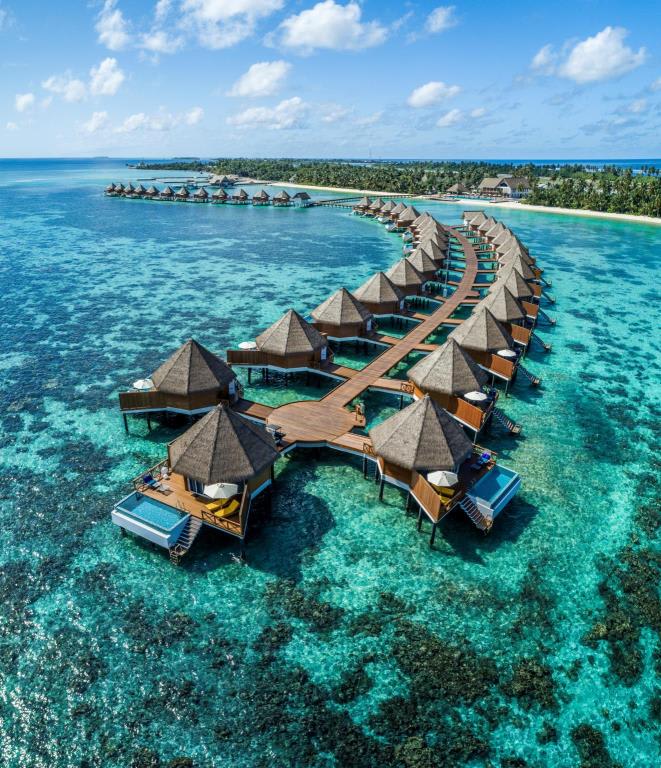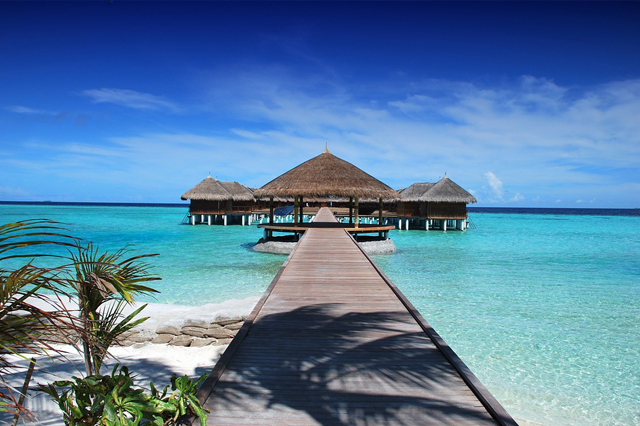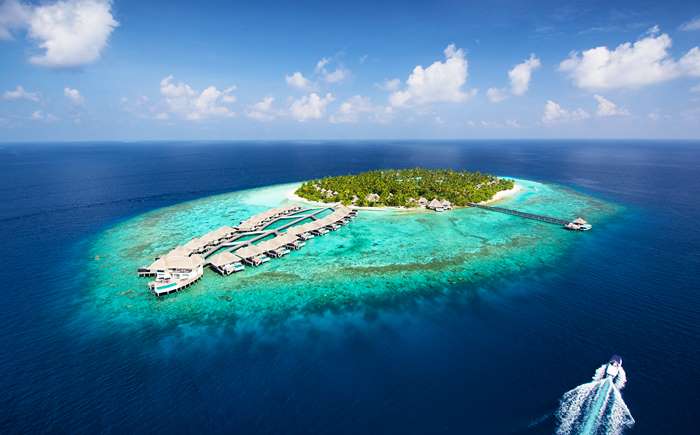About Maldives -- what a beautiful island !!!
The Republic of Maldives is an archipelago consisting of 26 atolls situated in the Indian Ocean. This chain of islands, stretching across in a north-south direction, lies across the equator between 7° 6′ 30″ and 0° 41′ 48″ south and between 72° 32′ 30″ and 73° 45′ 54″ east of Greenwich. The closest neighbours of Maldives are India (595 km) to the north, Sri Lanka (670 km) to the northeast and the Chagos Archipelago (550 km) directly to the south.
Ninety-nine percent of the Maldives is made up of sea. In both land area and size, Maldives is the smallest country in Asia. With an average ground level of 1.5m (4ft 11in), Maldives is the lowest-lying country in the world. Its highest point, which stands 2.3m (7ft 7in) above sea level is the world’s lowest naturally highest point.
The people of the islands are widely dispersed across the atolls. Only 200 islands are inhabited. About 90 islands are developed as tourist resorts and the rest are uninhabited or used for agriculture and other livelihood purposes.
The capital city of Maldives is Male’, which is also the most populous city in the country. The Maldives is a 100% Muslim country, making it the smallest Muslim country in the world.

Geography
Maldives consists of a double chain of 1,190 coral islands oriented at a north-south direction in the Laccadives Sea in the Indian Ocean. These islands are grouped into 26 natural atolls, which for organisational purposes have been divided into 20 administrative atolls. The land area of this archipelago is approximately 298 sq km stretched across 118,000 sq km of water, which makes over 99% of the Maldives to be made of water! The equator cuts across the country between the southernmost atolls, laying Addu and Fuamulaku to the south and Huvadhu Atoll to the north.
With the average temperature at about 30 degrees Celsius throughout the year, the sun is a constant on most days, shining through treetops, creating lacy patterns on white sand, healing cold-bones with its warmth. Maldives has two distinct seasons; dry season (northeast monsoon) and wet season (southwest monsoon), with the former extending from January to March and the latter from mid-May to November. The average annual rainfall is 254cm (100in) in the north and 381cm (150in) in the south.
The Maldives is world renowned for its underwater wildlife. Maldivian waters are home to several ecosystems and harbour a variety of underwater flora and fauna.

Climate Change
The adverse effects of climate change is an existential threat to low-lying small island developing states such as the Maldives. Over the last twenty years the Maldives has been in the forefront to draw attention to the negative impacts of environmental degradation and sea – level rise. Earlier this year, the Intergovernmental Panel on Climate Change (IPCC) report confirmed what the Maldives has been advocating for the last two decades.
The Maldives is amongst the least contributors to greenhouse emissions, amounting to around 0.0003% of the world’s total emissions. Yet, it is one of the most affected! The Maldives is has often criticised the world’s inability to find a political solution to the problem due to the long-standing mistrust between States in climate negotiations and the unwillingness of those who contribute most, to admit their historical responsibility for global warming. The Maldives strongly believes that for the global debate on climate change to move forward, industrialised countries should accept ambitious and binding emission reduction targets consistent with stabilising greenhouse gas concentrations. It is undoubtedly paramount to manage global temperatures to less than 1.5 degree Celsius compared to pre-industrial levels, and any increase of more than 2 degrees would be catastrophic for the entire humanity.
The Maldives has also supported the need to adopt sustainable developmental policies together with smart climate resilient strategies that is moving some societies and economies towards a positive trajectory that will transform them into more resilient ones.
Language
The official language of the Maldives is Dhivehi, a language that is only spoken in the nation. The origin of this unique language is believed by most researched to be in Sanskrit and Elu, the ancient language of the Sinhalese in Sri Lanka. It belongs to the Indro-Indian group of languages and depicts strong affinities with the major languages of the region. Following the advent of Islam in the 12th Century, the language has borrowed liberally from the Arabic language, and more recently with the introduction of English medium education, the influence of English on the development of Dhivehi language in modern times is no less significant.
As the islands of the Maldives are widely dispersed, spoken Dhivehi can vary widely in vocabulary and pronunciation between atolls as well as islands, with the southern most islands having the most significantly distinct dialect.
Dhivehi script, known as Thaana, is written from right to left, similar to the Arabic language. This new script was invented in the 16th century, following the liberation of the country from the Portuguese.
There are 24 letters in the Thaana alphabet and 11 separate vowel sounds, which are placed either above or below the alphabet letter designating the soundMaldives Culture & Traditions
The Maldivian ethnic identity is a blend of the cultures reflecting the peoples who settled on the islands, reinforced by religion and language. The earliest settlers were probably from southern India and Sri Lanka. They are linguistically and ethnically related to the people in the Indian subcontinent. They are ethnically known as Dhivehis.
Maldivian culture is heavily influenced by geographical proximity to Sri Lanka and southern India. The official and common language is Dhivehi, an Indo-European language having some similarities with “Elu”, the ancient Sinhalese language.
After the long Buddhist period of Maldivian history,
Muslim traders introduced Sunni Islam. Maldivians converted to Islam by
the mid-12th century. Since the 12th century AD there were also
influences from Arabia in the language and culture of the Maldives
because of the conversion to Islam and its location as a crossroads in
the central Indian Ocean. This was due to the long trading history
between the Far East and the Middle East.
Art and Craft
The mixing of cultures is very much seen in Maldivian arts. The music played with the local bodu-beru (big-drum) resembles that of African drumming. The dhoni (a unique Maldivian sailboat) is an art form itself built with skilled craftsmanship, with significant similarities to the Arabian dows. The fine artistry of Maldivians, seen in the intricate details on wooden beams in antique mosques, represents what we have gained from Southeast Asian architecture. Then there is the undefined: the distinct geometric designs used in mats woven from local materials, the embroidered neckline of women’s traditional dresses and their ornaments too, expose another story brought in from an unknown culture that has seeped in to Maldivian society.
The beautifully carved tombstones in some of the old cemeteries and the fine stone carving of the Hukuru Miskiiy in Male’ bear witness to the intricate skills of Maldivian stone carvers of the past. Maldivians are deft craftsman producing beautifully crafted pieces mostly out of what is available locally. Although many of the skills have been passed on from generation to generation and lives on even today.
Maldivian Cuisine
Traditional Maldivian cuisine is based on the following three main items and their derivatives: The coconut is used in the grated form, squeezed to obtain coconut milk, or as coconut oil in dishes that are deep-fried. The coconut milk is an essential ingredient in many Maldivian curries and other dishes. The favourite fish is skipjack tuna, either dried or fresh. Dry processed tuna is mainly used to make short eats called gulha, kavaabu, bajiyaa (the local version of the Indian samosa), and fatafolhi. Starchy items like rice, which is eaten boiled or ground into flour, tubers like taro (ala), sweet potato (kattala), or tapioca (dandialuvi), as well as fruits like breadfruit (bambukeyo) or screwpine (kashikeyo). Tubers and breadfruit are eaten boiled. The screwpine fruit is mostly eaten raw after having been cut into thin slices.
The Maldives are the stuff dreams are made of -- as in dream vacations inspired by those impossibly perfect pictures you've seen, or those pesky fantasies about quitting your day to live on an exotic island job for the rest of your life. You know, the places that can't possibly live up to your expectations of beauty and wonder. Well, we found out that the Maldives actually does live up to every single expectation. It looks exactly like those stock images floating across your screen: bright sun, transparent blue lagoons, house reefs teeming with fish, low waters with baby reef sharks and rays, and white sand beaches that stretch out into nothing but miles and miles of turquoise waters and blue skies.
While the image of the Maldives is familiar, there are likely a few surprising things you don't know about this South Asian island nation. That's especially true because a visit here is an investment: There are a fair few budget properties in the Maldives, and everything from food to getting around is pricey. You'll also need to take into account when is the best time to visit the Maldives, and what local customs you'll need to abide by while you're here.
The Maldives is made up of around 1,190 individual islands peppered across the Indian Ocean, located to the south and west of India and Sri Lanka . But we aren’t talking about an archipelago like Hawaii here — some of the islands in the Maldives are so small that you’ll have to zoom in all the way on your Google map before you even notice they’re there. Others are barely more than a strip of sand jutting out of the water. That means that, aside from the most populous island of Male, many islands have no more than one resort or hotel on them.
Out of the hundreds of islands within the Maldives, there are 26 different atolls (or collections of islands). But only about 200 of those are actually inhabited by people. These include islands with year-round, permanent populations like Male island, as well as farming towns and fishing villages. There are also islands where tourists are prohibited from visiting, despite being populated by locals. Aside from these, the uninhabited islands of the Maldives are used for farm or industry, or as “picnic” islands for resorts, which tourists can visit for the day for private, romantic meals.
If you need any kind of encouragement to get you to finally take that dream trip to the Maldives, let it be this — it might be dissappering . In fact, several dozen islands have already disappeared thanks to natural erosion from the sea, natural disasters like 2004’s Indian Ocean tsunami, and rising sea levels. Additionally, coral is the geological basis for most of the islands in the Maldives, and is particularly sensitive to rises in ocean and sea temperatures (those are going up in this part of the world, for the record).
And even if it takes some time for islands to start disappearing, the lack of potable water due to the salty seas interfering with fresh-water aquifers, as well as flooding, will pose risks to human life. What’s more? The reefs upon which the Maldives sit provide the fisheries that sustain much of the life and economic activity of these islands.Even if these facts aren’t alarming enough, for many of the remaining islands, beach erosion continues to be a huge problem — so don’t be surprised if you see seawalls built around the islands to help break waves or pumps on the beaches, pumping sand back onto land.
One of the rarest treats for travelers heading to the world’s beaches is stumbling across a bioluminescent stretch of sea. There are only a handful of places around the world where bioluminescent phytoplankton light up the water year round. In the Maldives, the phenomenon has a habit of showing up here and there throughout the archipelago. However, there are a few places where you can see the oceans aglow more reliably. That includes the Dusit Thani Maldives in the Baa Atoll. During certain times of the year, this resort’s beach comes alive with light — at night — giving off a starry-sky look in the dark waves. We were lucky enough to witness the spectacle during our visit, though other spots in the Maldives may offer similar experiences as well. It’s an unforgettable experience, but be sure to check on the timing of this spectacle with the hotel if you’re booking specifically to witness the lights.

To be clear: Foreign travelers to the Maldives are unlikely to encounter many infringements upon their vacationing freedoms. However, you should know that this is a Muslim country. In fact, the only other country in the entire world with a 100-percent Muslim population is Saudi Arabia. Keep this in mind when you plan your trip, especially if it coincides with Ramadan. During this month of fasting and prayer, most of the local staff you’ll be encountering at the airport and resorts will be unable to eat or drink anything during daylight hours and many shops and services — including on resort islands — will be closed at certain times for prayer. Because this is a strictly Muslim country, there are specific bans on some things you may bring into the Maldives. To avoid any hassle or confusion at the airport, leave the pork products, alcohol (even duty-free from a connecting stop), tobacco products without a health warning printed on them, and any religious texts (including the Bible) that may be construed outside of personal use — at home.
Since the Maldives is a Muslim country, there are a few extremely important and strictly enforced rules that you may not know exist. For example, there is no alcohol available in the cities and towns — strict Muslims aren’t even allowed to touch anything that contains alcohol. Homosexuality is also highly frowned upon and illegal in the country. Women are barred from wearing bathings suits or revealing clothing (i.e. nothing revealing the elbows, shoulders, or knees) in the towns and cities. Other restrictions include pork products, public displays of affection, and even quick kisses — all are against the law. While the Maldives is generally a bit more lenient on clothing restrictions for visitors arriving at the airport, we think it’s always good form to be respectful when in a foreign country. With that in mind, dress modestly as you pass through the airport and onward toward your resort. If you’re only planning on staying in hotels in Male or other larger inhabited islands, you should expect to abide by these laws at all times, as you’ll likely be leaving your hotel. If you’re on a resort island, the story is much different.

Perhaps it’s no surprise that a remote outpost of thousands of micro-islands, flush with private overwater bungalows and luxury resorts is expensive. It sort of goes without saying, to be honest. However, there are some nominally budget-friendly secrets for travelers looking to save some money. For starters, it’s cheaper for Europeans, those in South and Southeast Asia, and Middle Eastern residents to get here. For those travelers, combining lower airfare with budget-friendly hotels in the major inhabited islands and bigger cities, like Male, will mean you’re paying less. However, you’ll have to adhere by the local customs and plan to shell out to get to the beaches and other atolls.
If you’re considering an upscale or luxury resort getaway on a private island, you’re looking at average rates of around $500 per night in the high season. Many of these resorts are all-inclusive, so your soft drinks and food will be included. However, you may have to pay extra for alcohol, as well as any activities and spa treatments. If you’re not staying in an all-inclusive resort, expect to pay a huge premium on all meals and drinks. Don’t forget to add on the cost of the seaplane ride to your resort, as detailed above. In conclusion: The Maldives is a special-occasion kind of place, unless you’re incredibly rich. But with these kinds of views, and the stunning level of service found at many resorts, it’s really a once-in-a-lifetime experience.



No comments